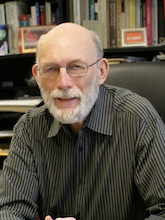Dr. David Van Nuys (the host of Shrink Rap Radio) visits with Dr. Paul Swingle about the coming integration of neuroscience and psychotherapy to create a more comprehensive approach to treating mental illness, an approach being called neurotherapy by some - Swingle refers to his own approach as Clinical psychoneurophysiology, which he defines as follows:
Psychoneurophysiology is a natural and holistic approach to the treatment of many conditions. We normalize and optimize brain functioning using various neurotherapeutic techniques including brainwave biofeedback, brain stimulation, cranial sacral therapy and self-regulation procedures. Treatment methods include brainwave biofeedback, brain stimulation and self-regulation to optimize brain functioning and correct inefficiencies in brain activity. Psychoneurophysiology corrects problems where they reside, in your head. The clinic treats numerous disorders such as ADD, ADHD, epilepsy, stroke, learning disorders, traumatic brain injury, depression, fibromyalgia, autistic spectrum disorders, to name but a few without dangerous and largely ineffective drugs.This sounds a little more integrated than other forms of neurotherapy I have seen - although I would need to know more to fully endorse this model. Still, it's an interesting podcast.
CRANIAL SACRAL THERAPY
Cranial Sacral Therapy (CST) is a gentle hands-on therapy which uses a light touch and gentle movements to monitor the rhythm of cerebral-spinal fluid (CSF) throughout the body. CSF surrounds, safeguards and provides nourishment for the brain and spinal cord and membranes. The pumping motion of this fluid creates a subtle pulse (detected through the palpation of bones) similar to that of a heartbeat which can be felt throughout the body. This rhythm is monitored by applying light pressure at specific evaluation points through the length of the body (head, neck, spinal cord, lower back and ankles). With CST, the natural rhythm of the cranial sacral function is restored, blood and oxygen flow are improved, toxins are removed more efficiently and brain cells function more effectively as they are receiving the nutrients they require. With CST individuals generally feel a release from stress and anxiety and begin to enjoy a renewed sense of well-being which facilitates neurotherapeutic treatment.
SOMATOEMOTIONAL RELEASE
SomatoEmotional Release (SER), an advanced form of Cranial Sacral Therapy, is a therapeutic process which locates and releases the mind and body from previous trauma and past negative emotional experiences. The body often retains physical and emotional imprints as the result of trauma. These imprints become isolated and dysfunctional and create energy cysts in body tissue. Initially, the body is able to adapt to these energy cysts, however, over time, the body loses its ability to adapt effectively and additional energy is required to carry out the most basic of functions. Suppressed physical and emotional trauma lay the foundation for many ailments. By locating and releasing the energy cysts, internal energy is able to flow freely and can markedly accelerate the neurotherapeutic process.
Shrink Rap Radio #319 – On The Frontier of Neurotherapy with Paul Swingle PhD
Paul G. Swingle,PhD was Titular Full Professor of Psychology at the University of Ottawa prior to moving to Vancouver. A Fellow of the Canadian Psychological Association, Dr. Swingle was Lecturer in Psychiatry at Harvard Medical School, an Attending Psychologist at McLean Hospital (Boston) where he also was Coordinator of the Clinical Psychophysiology Service. Dr. Swingle is a Registered Psychologist in British Columbia, Certified in Biofeedback and Neurotherapy. His latest book “Biofeedback for the Brain” is published by Rutgers University Press.
Check out the following Psychology CE Courses based on listening to Shrink Rap Radio interviews:
- Jungian Psychotherapy Part 1 (6 CEUs)
- Jungian Psychotherapy Part 2 (7 CEUs)
- Jungian Psychotherapy Part 3 (7 CEUs)
- Jungian Psychotherapy Part 4 (6 CEUs)
- Jungian Psychotherapy Package of the Four Above (26 CEUs)
- Wisdom of The Dream (4 CEUs)
- Positive Psychology (6 CEUs)
- Pros and Cons of Positive Psychology (5 CEUs)
- CERTIFICATE PROGRAM IN POSITIVE PSYCHOLOGY (32 CEUs)
- Body-Mind: Goodbye to Dualism (6 CEUs)
- Spirit-Meditation: Nurturing The Inner World (8 CEUs)
- Get our iPhone/Android app!
A psychology podcast by David Van Nuys, Ph.D.
copyright 2012: David Van Nuys, Ph.D.



No comments:
Post a Comment